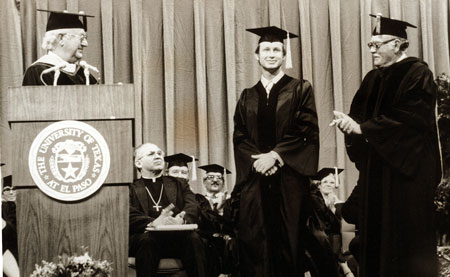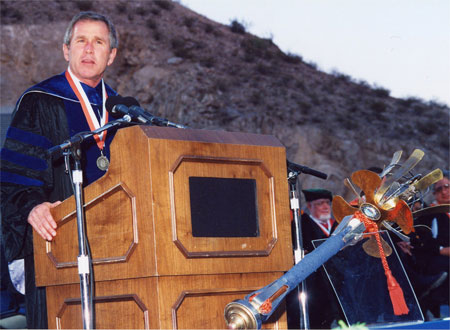Originally published May 11, 2016
By Christina Rodriguez
UTEP Communications
Each spring and fall, thousands of University of Texas at El Paso graduates in caps and gowns fill the Don Haskins Center, eager to participate in a ceremony signifying an important milestones in their lives – college graduation. Through the years, tens of thousands of proud UTEP Miners have enthusiastically attended Commencement ceremonies that not only honor their academic achievements, but also serve as a rite of passage that propels them into the next phase of their lives.
These ceremonies are part of a long and auspicious tradition that began a century ago.

On May 30, 1916, the State School of Mines and Metallurgy held its very first Commencement ceremony, just two years after the school’s formal opening in 1914. The quaint ceremony took place in the auditorium of the school’s main building, which was then located adjacent to Fort Bliss. The auditorium was decked out in orange and white, the official University of Texas colors, as the school was a branch of The University of Texas located in Austin.
Despite the enthusiasm of the community and the school’s first dean, Steve Worrell, the School of Mines’ first Commencement almost did not take place. Worrell believed he had the authority to confer degrees, but William Battle, president of The University of Texas, quickly informed Worrell that the school was under the direction of the UT Board of Regents and therefore, Worrell did not have such authority. The candidates for graduation had previously attended mining schools in New Mexico and Missouri, giving them advanced standing and merit to receive their degrees, which was enough to convince Battle to allow the ceremony to continue. The degrees were then conferred by the Board of Regents retroactively the day after the ceremony.
During the 1916 ceremony, three graduates – Vere Leasure, Lloyd Nelson and Clyde Ney – received an Engineer of Mines degree, a three-year professional degree.
The El Paso Morning Times predicted the potential and ultimate success of the University in the recap that was published the following day, May 31, 1916.
“From an educational point of view it was probably one of the most important events in the history of El Paso,” the newspaper stated, since the school not only made El Paso a “University town,” it was also “destined to be one of the greatest technical and professional colleges in the entire west.”
The initial 1916 ceremony marked the only time until 1933 that a commencement ceremony would take place on campus. The 1933 ceremony was held outdoors on the tennis courts where the Psychology Building is currently located. In later years, various locations were used to host the ceremonies on and off campus. In 1977, Commencement found its new and permanent home at the Special Events Center, now called the Don Haskins Center, with the exception of the Spring Commencements held at Sun Bowl Stadium in 1998 and 2014.
In the early years, the number of candidates for graduation remained small. During the 1918 and 1919 ceremonies, the School of Mines celebrated only one graduate. A historical turning point took place during the 1932 Commencement ceremony for two reasons: it was the first time the College of Mines, as it was known then, began awarding Bachelor of Arts degrees; and it was the first Commencement that included female degree candidates. In total, there were nine Bachelor of Arts degrees awarded that year, all received by female graduates, and 11 Bachelor of Science degrees awarded in engineering. The number of graduates from that point continued to increase steadily each year.
Notably, the Commencement ceremony of 1944, held in the midst of World War II, was the first all-female graduating class with 16 women receiving Bachelor of Arts degrees and one earning a Bachelor of Science.
Another Commencement milestone took place in 1942 when the College of Mines awarded its first three master’s degrees. College President Dossie Wiggins had submitted a formal request to the UT Board of Regents the previous year to offer graduate-level degrees. There was a tremendous demand, and the College of Mines was the only four-year senior college in the state of Texas that did not offer graduate degrees. Wiggins’ request was approved and the college began offering Masters of Arts degrees in English, education and history.
Gary Massingill received the first doctoral degree from UTEP in 1979, in geological sciences.
Today, UTEP offers 72 bachelor’s, 73 master’s and 21 doctoral degrees.
Another notable transition in Commencement practices through the years was in the attire faculty were expected to wear during the ceremonies. According to PJ Vierra, UTEP doctoral candidate in rhetoric and composition who has studied UTEP history, schools of mines typically followed a very strict, progressive model.
“Under progressive thinking, engineers were regarded as the professionals who were going to make America better,” Vierra said. “They were going to come up with all these projects and build dams, bridges, buildings, etc. that would be the backbone of America. Therefore, they had to have a lot in common with the ‘ordinary man’ so they would not be seen as elite.” For this reason, faculty were expected to wear suits instead of traditional Commencement regalia. When John Kidd, who was very much influenced by the progressive model, became dean of the College of Mines in 1923, he insisted that faculty wear the progressive “democratic dress” for Commencement.
Throughout the 1930s, the dynamic of the University changed and the College of Mines was no longer just an engineering school but also a liberal arts college. Faculty members began joining the college from very traditional prestigious universities. When Dossie Wiggins, who received his doctorate from Yale University, was named college president in 1935, the faculty began to wear their formal academic robes and caps during Commencement for the first time.

Throughout the long history of Commencement ceremonies, the University has welcomed a long list of notable speakers, including local elected officials, district judges, business leaders, university presidents, ministers and even two future U.S. presidents. Former U.S. President George H.W. Bush, then vice president, spoke at UTEP’s Spring Commencement ceremony in 1987, while former U.S. President George W. Bush, then governor of Texas, gave UTEP’s Commencement address in 1998.
Over the past century, UTEP’s Commencement has adapted to the ever-changing needs of the University. When the number of graduates was small, only one ceremony took place annually. Under a catalog rule, graduates had to attend a commencement ceremony that corresponded with their graduation date in order to receive their degrees, creating the need for multiple commencements throughout the academic year. At one time, the college held three commencements each year. The catalog rule was dropped in 1962, eliminating the need for multiple commencements within an academic year.
However, in order to meet the demands of an increased number of graduates, a Winter Commencement was added again in 1982, and in 2008, the University adopted the current schedule of two Commencements per year with three ceremonies each. Currently, more than 5,000 graduates receive their degrees from UTEP each year, carrying on the tradition that began with the first three Miners 100 years ago.
PJ Vierra, UTEP doctoral candidate in rhetoric and composition, contributed to this story. Funding for the research that informed this story came from a Dodson Research Grant.